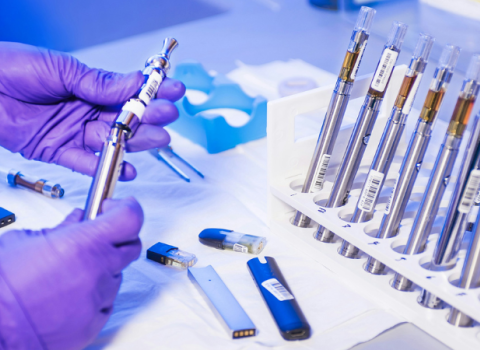Dutch researchers at the BMTI Institute for Biomedical Technology are developing techniques for using gold nanoparticles in the early detection of cancer.
The particles are linked to cancer-specific antibodies that are able to home in on tumour cells in the body. Using photoacoustics, a technique which combines laser light with ultrasound, it is then possible to detect the particles when they lock onto tumour cells, at a far earlier stage in the development of a tumour that is possible currently. The work is funded by the Dutch research programme IOP Photonic Devices.
Gold nanoparticles are expected to be useful for developing cancer therapies also. The nanoparticles heat rapidly when bathed in infrared light, with the shape of the particles determining the wavelength at which this happens. Temperatures of up to 100 degrees can be induced, opening up the possibility of photothermal therapies in which the nanoparticles are first targeted at cancer cells and then irradiated with infrared light.
Both diagnostic and therapeutic applications are being investigated by the scientists together with colleagues from the Erasmus MC in Rotterdam and two companies, Esoate Europe and Luminostix.
The project is financed from the innovation oriented programme IOP Photonic Devices of the Dutch Ministry of Economic Affairs.
The particles are linked to cancer-specific antibodies that are able to home in on tumour cells in the body. Using photoacoustics, a technique which combines laser light with ultrasound, it is then possible to detect the particles when they lock onto tumour cells, at a far earlier stage in the development of a tumour that is possible currently. The work is funded by the Dutch research programme IOP Photonic Devices.
Gold nanoparticles are expected to be useful for developing cancer therapies also. The nanoparticles heat rapidly when bathed in infrared light, with the shape of the particles determining the wavelength at which this happens. Temperatures of up to 100 degrees can be induced, opening up the possibility of photothermal therapies in which the nanoparticles are first targeted at cancer cells and then irradiated with infrared light.
Both diagnostic and therapeutic applications are being investigated by the scientists together with colleagues from the Erasmus MC in Rotterdam and two companies, Esoate Europe and Luminostix.
The project is financed from the innovation oriented programme IOP Photonic Devices of the Dutch Ministry of Economic Affairs.





 A unique international forum for public research organisations and companies to connect their external engagement with strategic interests around their R&D system.
A unique international forum for public research organisations and companies to connect their external engagement with strategic interests around their R&D system.